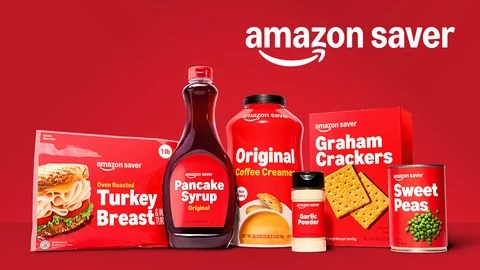
Amazon introduced grocery discounts for Prime members at Amazon Fresh and a new private-label brand called Amazon Saver.
“We’re always looking to make grocery shopping easier, faster and more affordable for our customers,” Claire Peters, worldwide vice president of Amazon Fresh, the company’s grocery arm, said in a news release Tuesday (Sept. 10).
The new campaign includes a “significant expansion” of Amazon’s exclusive Prime savings program at Amazon Fresh, both in-store and online, letting shoppers get discounts of up to 50% off eight to 15 rotating items, such as fresh produce or pantry staples, the release said.
The company is also adding Amazon Saver to its existing private-label offerings, which include Amazon Kitchen and 365 by Whole Foods Market. The new offering is a “no-frills” brand with most items priced under $5, per the release.
The announcement follows last week’s news that Amazon is expanding its footprint in the third-party grocery delivery space, allowing consumers in Seattle to order same-day grocery delivery from local merchant Metropolitan Market on Amazon’s marketplace.
On the opposite side of the country, Amazon is expanding its grocery delivery partnership with mid-Atlantic-based supermarket chain Weis Markets to six new locations.
“The move comes as Amazon looks to grow its presence in grocery — the one retail category in which it trails behind competitor Walmart by a wide margin,” PYMNTS noted in that report.
The most recent edition of PYMNTS Intelligence’s Whole Paycheck Report, “Walmart Holds Grocery Lead Over Amazon Despite Overall Share Declines,” showed that as of the second quarter of the year, Walmart drew a share of consumer grocery spending seven times the size of Amazon’s, at a respective 20% and 2.7%.
Meanwhile, PYMNTS examined consumers’ appetites for private labels last month in an interview with Bobby Watts of supermarket giant Ahold Delhaize USA.
“They’re not as brand loyal as they used to be,” Watts said. “… I think it’s [because of] two things. I definitely think that economic pressures are causing consumers to make choices … based on price or promotion or value. But we also see … the younger generation has grown up in a world where everything is instantaneous, and things are moving at such a fast pace that they’re willing now to experiment more and test different brands, whereas the other demographics may not be as apt to do so.”